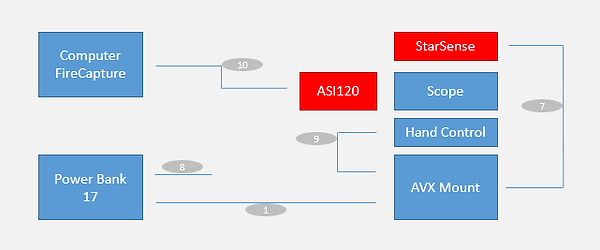AstroBKK
Planetary Acquisition
Telescope: Celestron 9.25"
Camera: ASI120MC-S
Barlow 2X GSO or Superview Projection Eyepiece 30mm (GSO)
Mount: AVX
StarSense module
Rig scheme:
Numbers below refer to cables listed in DSO Rig Operation page.


Optical train:
1 - Barlow 2X
This planetary optical train features a 2X Barlow inserted at a length similar to that in obtained in visual configuration with the 2" diagonal, which matches the telescope backfocus of 140mm for eyepieces. The lens module is located at the end of the Barlow's draw tube so it is rather located at a ~120mm, but its conception is calculated to deliver nominal 2X magnification despite not being located at backfocus distance, as it will be shown below. The train is built as follows: 50mm SCT to 2" adapter, 80mm 2" extender, Barlow fitted with it's lens module and it's 2" to 1.25" reducer, ASI120 camera fitted with a 1.25" nosepiece. Note that the 80mm extender is not fully inserted in the 50mm adapter, allowing an additional 10mm to reach overall 140mm, without imparting the rigidity of the assembly.

With the Barlow doubling the FL, this train should provide a sampling around 0.164 arsec/pix, ideal for very good seeing conditions. Jupiter apparent diameter (46.63") should cover 22% of ASI120 AR0130CS captor's length.
Actual measurements of Jupiter size on the captor (PIPP) indicated a coverage of 23%. From ephemeris apparent diameter (46.63"), it gives a slightly higher sampling of 0.155 arcsec/pix, indicating that Barlow lens operated at ~2.1X in this optical train configuration.
2 - Eyepiece projection
This planetary train is made from the following parts: 50mm SCT to 2" adapter, 80mm 2" extender, 2" 30mm projection eyepiece (adj. sleeve 0mm), M57 to T42 adaptor, T42-M48 ring (the adaptor and ring are shown screwed on the eyepiece in picture below), GSO M48 extensions (3*30mm and 1*20mm), Zwo M48 -T42 16.5mm adaptor, ASI120-MC camera (12.5mm inner light path before sensor). Scope's rear cell to eyepiece: 130mm, distance from eypiece to CCD: 139mm.

Theoretical sampling should be 0.091 arcsec/pic, and considering Jupiter ephemeris apparent diameter (46.85"), it should cover 40% of ASI120 captor's length. Actual measurement of Jupiter size indicated a sampling of 0.094 arcsec/pix and a magnification over prime focus by 3.5x (F/R 35), corresponding to a coverage of 39% captor length.
Alignment and Scope use:
After rough polar alignment, go-to was set with StarSense, see DSO rig procedure. Collimation is checked. Objects could fairly easily be found using spotting scope and centered in camera's FOV. Re-centering between captures was necessary from time to time (a polar alignment refining should improve this). Then focus is adjusted, preferably using Jupiter's moon if close enough.
Video acquisition with Firecapture:
In the Capture window, select the profile (Jupiter, Saturm) and choose destination file, and tick max. In the preview window, tick debayer to get a color image. In Control untick gamma and adjust histogram to ~2/3rd using gain and exposure sliders. Press the "More" button, and adjust blue and red colors. Set video file format to avi (files are big, enough disc space must be available on the computer). Finally, ensure capture time is 90sec or less if no derotation (Winjupos) step is intended, and 120sec or less for Saturn.
Capture is launched (play button) and must be monitored, as seeing may vary and saturates histogram (overexposure).
